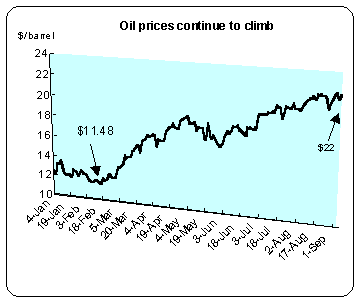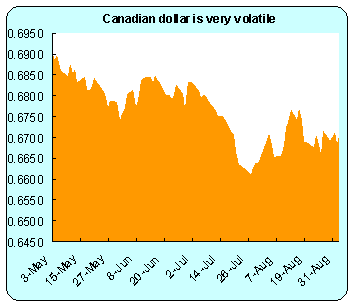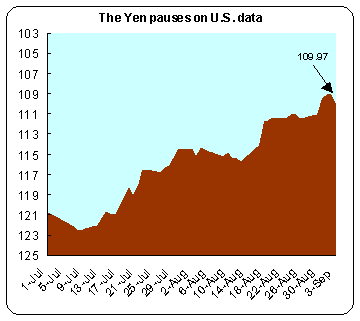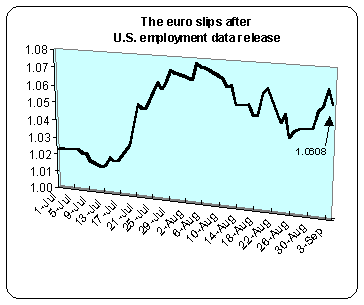
|
Today's Calendar |
| | Simply Economics |
| | International Perspective |
| | Resource Center |
 |
|
| 1999 Articles |
|
International Perspectives - September 7, 1999
Seeking inflationary signals
Oil The commodity markets' sensitivity was visible last Tuesday when oil prices zoomed after two oil producing country ministers indicated that they were not in favor of increasing production to meet the growing demand around the world. After a decade and a half of lying, cheating and squabbling, members of the OPEC seem to have got their act together, although most people thought it would never happen.  As a result, oil prices have doubled during the past six months, much to the surprise of the biggest oil companies and their shareholders. This strength reflects a growing consensus in the oil industry - after a period of skepticism in mid-summer - that higher oil prices are here to stay. Already Saudi, Venezuelan and Mexican officials have agreed to maintain output cuts through the end of next March. The ministers' statements emphasized the crucial role that strict compliance is playing in oil's recovery along with the importance of ensuring that an expected decline in global inventories actually materializes. Although OPEC appears set to adopt a status quo approach to quotas at their September 22nd meeting, recent surveys suggest that some producers began to edge up production last month. During the week, a chorus of influential members - including Iran, Mexico and Saudi Arabia - suggested that producers monitor and react to inventory levels instead of prices as proposed by Venezuela. The oil glut is shrinking and some analysts are forecasting a substantial inventory erosion beginning in October as the heating season approaches. However, a rapid reversal is always possible in a market that depends on the resolution of a few oil ministers to avoid temptation. As the price rises, the pressure to push up earnings by producing more oil becomes ever higher. However, the severe economic difficulties of many oil producing countries, such as Nigeria and Venezuela, appear to make discipline more likely. And although OPEC countries produce only about 40 per cent of the world's oil at present, they have nearly three-quarters of reserves. A re-run of the seventies' grim story when supplies shrank, oil prices skyrocketed and inflation soared is unlikely. Inflationary pressures remain extremely subdued despite the recent rise in oil and other non-food commodity prices. A large part of the world economy is just emerging from the threat of a deflationary recession. The unexpectedly strong signs of recovery in southeast Asia and a better outlook for Europe have helped to raise the demand for oil. The buildup of excess stocks has been reversed; but this would be a benign result of continued steady growth - if it can be sustained - in most of the industrialized world. The west has become far less dependent on oil. Six years of prices above $30 (in today's money) in the early 1980s led to big changes in consumption. This reflected not only deliberate policy, such as the encouragement of smaller car engines and improvements in industrial efficiency, but also the fact that energy intensive industries have become a declining part of advanced economies. In the period after 1985, when OPEC collapsed and oil prices fluctuated between about $15 and $20, the big oil companies made spectacular efficiency gains. The cost of finding, developing and operating a new source of oil has fallen to only about $6 per barrel, less than half the figures in the mid-1980s. A barrage of indicators
Asia The Bank of Japan terms of trade index for manufacturers fell 0.5 for July. The index had been flat since the beginning of the year. The main reason was rising oil prices, which outweighed the effect of the yen's appreciation. A combination of a strong yen and worsening terms of trade will undermine Japan's recovery. Japan's imports from Asia rose 2.3 percent during April-June when compared with a year ago. This is positive news for the region, and also reflects a demand recovery in Japan. The yen and the Japanese stock market soared on the market's positive sentiment about the economy. South Korea - Industrial output soared 33.1 percent in July, shifting from a fall of 14 percent a year earlier, thanks to rising exports and a pickup in domestic consumption. The rise is the highest since August 1976, when output surged 35.1 percent. Australia - The trade deficit narrowed more than expected in July, helped by a jump in exports as demand for Australian goods picked up in Asia and Europe. Analysts expect the contraction to continue in the coming months, helping to narrow the current account deficit, which hit about 6.2 percent of gross domestic product in the second quarter.
Europe Germany - Nominal wholesale sales for July fell 3.7 percent compared with a year earlier and sales were down 3.0 percent after adjustment for inflation. Nominal wholesale sales in July rose a seasonally and calendar-adjusted 1.2 percent on the month. France - The ILO rate fell to 11.2 percent from 11.3 percent in June. Manufacturing output in June rose a seasonally and workday adjusted 0.9 percent on the month and 0.7 percent on the year. This was much stronger than most analysts had expected. The International Labor Organization (ILO) definition of unemployment excludes job seekers that did any work in the month. Italy -Producer prices in June rose 0.6 percent on the month but fell 0.7 percent on the year. The increase was expected, given the rise in oil prices and the stronger dollar. June adjusted retail sales rose 2.3 percent on the year, the highest level since December. The July non-EU trade surplus narrowed in line with expectations, with imports rising and the fall in exports is slowing. Several European Purchasing Managers Index (PMI) surveys were released with mixed results. The European Monetary Union eleven overall reading gained slightly in August, as did Germany and Italy. Sweden's PMI rose to 60.9 from a previous reading of 49.2. (Scandinavian PMI's have tended to be quite volatile on a month by month basis.) Both the UK and France experienced slight dips. However, a common theme among all the indices was the rise in the price component. This is largely because of the recent rise in oil prices. Nevertheless, while the readings in August have not produced significant improvements, most of the increases experienced in the previous two months should be enough to support an improvement in the industrial production trend going into the third quarter.
Americas
Equity Markets
Asian markets were closed by the time the U.S. employment situation report was released. As a result, the South Korean and Australian markets finished down on the week while Japan stayed about the same despite intra-week volatility. Currencies  The Canadian dollar alternately weakened and strengthened last week depending upon the markets' shifting views on U.S. interest rates. Now, interest rate spreads and Federal Reserve policy are the primary focus of the market, taking over from commodity prices which had been the day to day driving force of the Canadian dollar. The U.S. dollar rose against the yen and euro when a weaker than expected U.S. employment report was released. The report implied lower wage pressures. The markets' diminished concern - at least on Friday - that the FOMC is less likely to raise interest rates in October sent stocks soaring. However, the euphoria is sure to pass as the markets begin to focus on the U.S. inflation reports due this week and next.  The dollar fell to new lows last week against the yen, as intervention became less of a threat. The market overlooked weaker than expected data. Japanese economic performance will come into greater focus this week when second quarter gross domestic product is released. With stronger growth in Europe and Great Britain, policies of the European Central Bank and the Bank of England are coming into focus. Both policy councils meet this week. While analysts are not expecting rate increases yet, the statements following the meetings will be closely studied for hints of future action. 
Why U.S. investors care...
The following indicators will be released this week.
Release dates are subject to change. |
|||||||||||||||||||||||||||||||||||||||||||||||||||||||||||||||||||||||||||||||||||||||||||||||||||||||||||||||||||||||||||||||||||||||||||||||||||